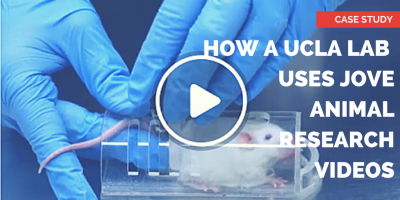THE BIG PICTURE
By using JoVE animal research video training articles, a UCLA lab, over 2.5 years, saved thousands of hours and thousands of dollars by cutting lab training time, and animal and resource expenses.
THE LAB
The University of California Los Angeles Humanized Mouse Core laboratory provides infrastructure, materials, animals, technical expertise and support to researchers of HIV-induced disease. The lab specializes in using human hematopoietic tissue to enable in-vivo experimentation and observation.
THE PROBLEM
Working with HIV-exposed animals is innately dangerous, through accidental needle puncture or biting, says Valerie Rezek, lab manager at the Mouse Core. Additionally, the cost of these immune-compromised mice is relatively high, around $45 per animal, as opposed to the industry average of about $8 (for an immune-competent mouse).
Maintaining staff safety and preventing unnecessary risk to the animals during handling demands special training. To that end, UCLA provides basic introductory group classes, which require some supplemental personalized tutoring. As Rezek says: “I don’t think you can really learn everything you need to know in a one- or two-hour training session.”
To reinforce the basic lessons, Rezek was repeatedly tasked with providing time- and energy-consuming individual training sessions. And besides maintaining safety, she also needed to make the training process more efficient, with improved teaching outcomes. Eventually, Rezek decided she required flexible, high-quality, video-based training resources.
THE JoVE SOLUTION
Because of the sensitive nature of animal research, the Mouse Core lab couldn't make and distribute its own pictures or videos. After some research, Rezek selected a JoVE subscription to assist in teaching relevant protocols. She explains that JoVE definitely offers more proven and quality content than what you generally can find on YouTube. There, a protocol demonstration probably isn’t done with any kind of safety standardization or official approval.
And, she adds: “I know other labs that we work with are also familiar with JoVE, and people have also published videos there. It’s generally accepted that JoVE is a well-regarded journal.”
Unlike videos on general science education or other streaming sites, JoVE's videos are produced at top labs (whose locations are identified). Additionally, JoVE explains that all protocols are done according to standards. The videos also feature world-class researchers performing their own experiments, and clearly demonstrating the procedures. The video quality is also excellent, even enabling a clear view of such things as the inside of a microscope.
“You know JoVE offers actual published papers, and all its protocols are really detailed, really thorough, so, I love it,” says Rezek. “You’ll know how to prepare the different reagents and concentrations. This is helpful if you’re starting something new and need to learn quickly.”
RESULTS

Using videos from the Lab Animal Research collection in JoVE’s Science Education Library has improved lab training for the staff members by reducing the amount of time Rezek must spend in individual sessions — without compromising safety and handling quality. Rezek just assigns JoVE articles that can be watched over and over at will.
Additionally, the videos show a variety of techniques for the lab staff members that they were previously unaware of. As Rezek says: “I will send people follow-up emails, with links to videos carrying the relevant protocols. They can go through the lesson and they'll have the text of what we have discussed. Then they can see videos and pictures of the positioning (when holding the animals), and the procedures.”
Among the quantifiable results in time, materials, and human salary value over 2.5 years, the Mouse Core realized:
- A reduction of about an hour of training time per staff member per month.
- Savings of an hour per month for Rezek in training activity.
- About $2,250 in savings in special bone marrow, liver, thymus (BLT) humanized mice (one mouse/every other month). This is done through improved handling, and the reduction in the need of test mice. Better training means less stress for the animals, and the avoidance of sacrificing them unnecessarily.
- The reduction of some $5,700 in overall personnel costs, based on salaries.
- A savings of some 2,336 work hours through improved training, accelerating time to lab productivity (amounting to one half day for every two weeks for lab staff).
Rezek says: “I love JoVE. I think it provides a great teaching technique. I don't always have time to train people, and just sending them the video is great.”

